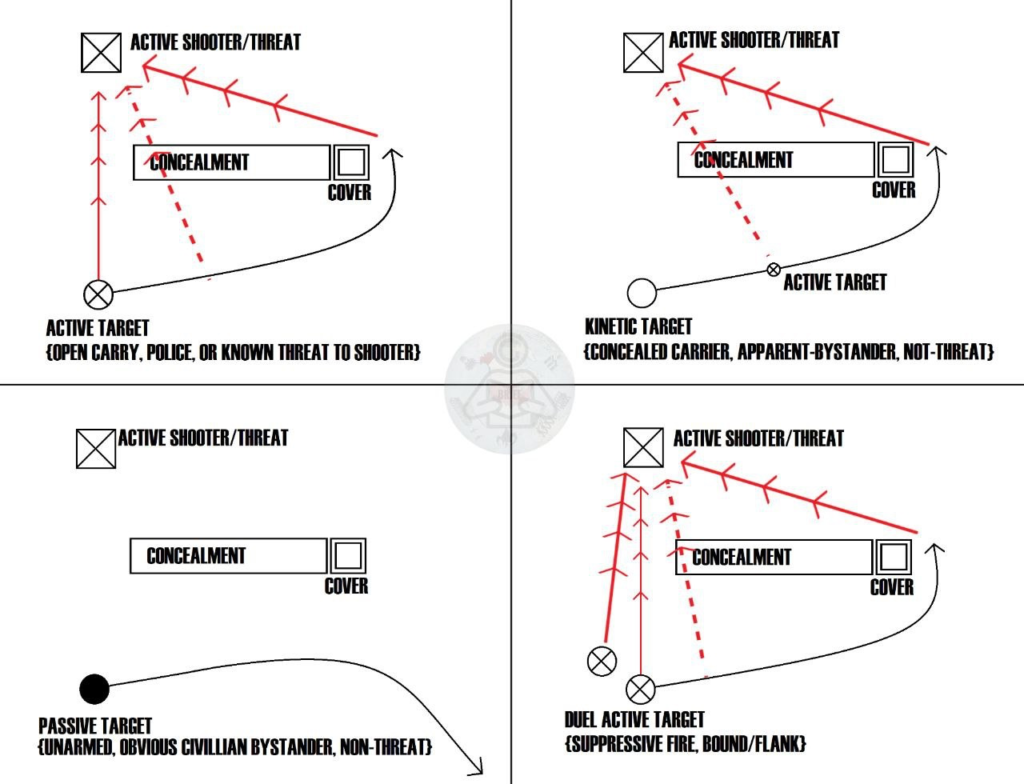Responding to an active threat (shooter) will vary based upon the attention of the threat, your readiness, and your carry status (whether or not you have a firearm and if it’s open or concealed carried). In the event a threat is actively engaging targets, you must take action. RUN, HIDE, FIGHT. There are endless scenarios and possible outcomes but in this “react to contact” drill we’ll highlight the 4 best courses of action (COAs).

FOUR COURSES OF ACTION
ACTIVE TARGET – The shooter sees you and determines you are a threat. You are openly carrying/holding a weapon, you are visibly dialing 911, or you are otherwise making yourself the shooter’s primary target.
COA: Engage, move from line of sight (LoS) across concealment (a barrier that masks you but doesn’t stop bullets) to cover (a barrier that stops bullets), reenage.
KINETIC TARGET – The shooter may see you but they are not actively targeting you due to the perception you are not a current threat to their goal. You are armed but carrying concealed and not wearing clothing that would identify you as a danger to the shooter.
COA: Move from LoS across concealment, draw weapon, engage if necessary while moving to cover, then engage upon cover.
PASSIVE TARGET – The shooter may see you but they are not actively targeting you due to the perception you are not a current threat to their goal. You are an unarmed bystander.
COA: Move across concealment, put cover between you and the shooter, exit the area or hide (shelter in place).
DUEL ACTIVE TARGET – Same as an active target but in this scenario you have an armed friendly.
COA: The closest friendly should immediately engage and provide suppressive fire while the other moves to cover, bounding as necessary, flanks and engages from shooter’s vulnerable side. Both should continue engaging from first encounter until threats are stopped.
I think we have room for one more tip. Let’s talk about Situational Awareness as it relates to your Vehicle’s Mirrors. Vehicle crashes and surveillance avoidance directly relate to your ability to see what’s happening on all four sides of your vehicle. Blind spots can be erased with correct mirror adjustments. Here’s how to make sure you can see what’s going on around you.
》The rear view mirror (RVM) should be focused on the rear, not the sides.
》The side mirrors shouldn’t be showing the side panel of your car, they should be aimed at the area between where your RVM vision ends and your peripheral vision begins. Tilt them so that you can just see the outline of your back doors’ handles.
》Erase blind spots by doing the following: While driving in the right lane, note a vehicle in the left lane overtaking you from behind. Without moving your head, follow its approach in your RVM. Just before it disappears from your view in the RVM, glance to the left side mirror. There it is. Now follow that vehicle in the side mirror as it begins to pass you. Then, just before it disappears from the side mirror, you should see it with your peripheral vision. Notice that without even turning your head, you never had a blind-spot. Make adjustments as needed.
This article was originally written by the Grayman Briefing. Stay in the know, sign up for Intel and Situational Awareness alerts pushed to your phone on emerging threats and preparedness warnings. Click HERE to subscribe to the Grayman Briefing.
